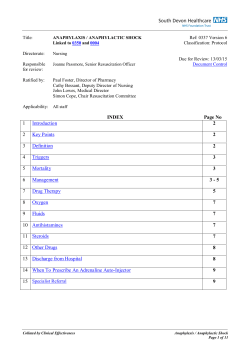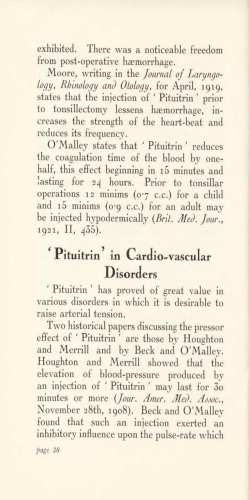
Prescribing information is available at the end of this presentation
Prescribing information is available at the end of this presentation JXT-004 Jext EAACI 2011 visual aid Jext adrenaline delivery in the heart-pounding panic of anaphylaxis ADRENALINE PENS SHOULD BE RELIABLE Current standard treatment has a shelf life of 18 months, requires storage below 25oC and protection from light at all times.1 Approximately 1/3 of patients fail to replace their pens within 18 months.2 - a significant percentage of patients carry emergency rescue medication which cannot be guaranteed effective Jext is reliable due to long shelf life and simple storage upgrade reliability Jext has a 24-month shelf life.3 Jext is effective above 25oC and does not require protection from light.3 Every Jext comes with a robust, protective carry case. Jext Current standard of care 18 months Maximum shelf-life from date of manufacture 24 months ADRENALINE PENS SHOULD BE EASY TO USE Currently available adrenaline pens have disadvantages that may limit their use and effectiveness.4-6 O nly 30–44% of patients were able to demonstrate correct Adrenaline Auto-Injector (AAI) technique.7 Jext is easy to use due to intuitive design upgrade ease of use C lear labelling. - Same two activation steps as current standard of care3 Illustrated instructions for use and directional arrows. C olour coded ends. - Yellow safety cap - Black needle end Despite training with current standard treatments, accidents happen and lives are at risk. M ore than 15,000 unintentional injections with adrenaline pens have been reported from 1994-2007.8 Jext is designed to deliver adrenaline correctly upgrade correct usage 11.64mm +-0-80 Cartridge AAIs appear to be significantly more capable of consistently delivering a quick, clinically relevant dose of I.M. adrenaline than syringe AAIs.4 21.09mm +-2.54 ADRENALINE SHOULD BE DELIVERED CORRECTLY P<0.01 Cartridge vs Syringe AAI Jext is designed to deliver adrenaline correctly upgrade correct usage Jext is a cartridge based device that administers adrenaline intramuscularly, ensuring rapid peak plasma concentration.3,4 Jext has colour coded ends to safeguard against accidental injection.3 - Yellow safety cap - Black needle end Jext has unique needle protection.3 - The Jext needle shield covers the needle and locks after injection,3 reducing the risk of subsequent needlestick injury lifetime care and support in anaphylaxis TO INCREASE THE CHANCES OF SURVIVING POTENTIALLY FATAL ANAPHYLAXIS, REGULAR TRAINING IN CORRECT AAI USE IS NEEDED7 Comprehensive training and free support materials for healthcare professionals and patients: Instructional video Downloadable resources Expiry alert service Jext Simulator To find out more go to www.life-saver.org upgrade correct usage UPGRADING TO JEXT COULDN’T BE SIMPLER Jext has the same two activation steps as current standard of care.1,3 This may assist patients who have previously used an AAI in understanding how to use Jext. Use the Jext Simulator to demonstrate how easy it is to use Jext. Jext the new standard of care for anaphylaxis based on more than a decade of experience with adrenaline auto-injectors RELIABLY L ongest shelf life E ffective above 25oC EASILY C lear labelling S imple instructions CORRECTLY Intramuscular delivery Lifesaver training programme Jext ® Auto-Injector abbreviated prescribing information. Presentation: Jext is a single-use, cartridge based adrenaline auto-injector designed for easy use. Jext 300 micrograms, delivers a single dose of 0.30ml of adrenaline (as tartrate), in a sterile solution. 1.1ml of adrenaline remains in the auto-injector after activation. Jext 150 micrograms delivers a single dose of 0.15ml of adrenaline (as tartrate) in a sterile solution. 1.25ml of adrenaline remains in the auto-injector after activation. The inspection window in the label is filled by a coloured plastic rod (white in Jext 300 and blue in Jext 150) to confirm that the auto-injector has activated and the adrenaline solution has been injected. Indication: Jext is indicated in the emergency treatment of severe acute allergic reactions (anaphylaxis) to insect stings or bites, foods, drugs and other allergens as well as idiopathic or exercise induced anaphylaxis. Dosage: ADULTS: Single use, self administration of 0.30ml adrenaline (Jext 300 micrograms) intramuscularly. CHILDREN: The appropriate dosage may be 0.15ml (Jext 150 micrograms) for children 15–30kg body weight and 0.30ml (Jext 300 micrograms) adrenaline for children >30kg body weight, or at the discretion of the physician. Administration: Jext is operated by simply pressing the black injector tip against the outer (anterolateral) thigh. This will activate a plunger, which pushes a concealed needle through the membrane on the black injector tip into the muscle and injects a dose of adrenaline. The yellow cap prevents the device from activating, and should not be removed before injection is required. The black injector tip should be kept away from the hand. Jext is designed to inject through clothing or directly through the skin. After administration massage around the injection area is advised to accelerate absorption. In the absence of clinical improvement or if deterioration occurs, a second injection with an additional Jext may be administered 5–15 minutes after the first injection. As Jext is designed for emergency treatment, the patient should always seek immediate medical attention even if symptoms have disappeared. Contra-indications: There are no absolute contraindications to the use of Jext during an allergic emergency. Warnings: Jext should only be administered into the outer (anterolateral) thigh. Avoid the risk of inadvertent intravascular injection. DO NOT INJECT INTO THE BUTTOCKS. Accidental injection into the hands or feet may result in loss of blood flow to the affected areas. Precautions: All patients who are prescribed Jext should be thoroughly instructed to understand the indications for use and the correct method of administration. Caution is indicated in patients receiving drugs that may sensitise the heart to arrhythmias, including digitalis and quinidine. The effects of adrenaline may be potentiated by tricyclic antidepressants, monoamine oxidase inhibitors (MAO-inhibitors) and catechol-O-methyl transferase inhibitors (COMT inhibitors). Adrenaline should be used in pregnancy only if the potential benefit justifies any potential risk to the foetus. Adverse events: May include palpitations, tachycardia, nausea and vomiting, respiratory difficulty, headache, dizziness and anxiety. Cardiac arrhythmias may follow administration of adrenaline. Overdoses of adrenaline may cause cerebral haemorrhage or arrhythmias. Shelf life: 2 years. Replace and discard the pre-filled pen if the solution is discoloured or contains a precipitate, or at the latest before the expiry date. The expiry date is indicated on the label and Jext should not be used after this date. Storage conditions: Do not freeze. Legal Category: POM Marketing Authorisation Numbers: PL 10085/0052. PL 10085/0053 Marketing Authorisation holder: ALK Abelló A/S, Bøge Alle 6-8, DK-2970 Hørsholm. Date of last revision: September 2010. References 1. EpiPen SmPC. Electronic Medicines Compendium (www.emc.medicines.org.uk). 2. Lombardelli S. Adrenaline auto-injectors. How effective are written patient instructions when used alone in a simulated self-administration test? Poster presented at The British Society of Allergy and Clinical Immunology, 2009. 3. Jext SmPC. Electronic Medicines Compendium (www.emc.medicines.org.uk). 4. Schwirtz A, Seeger H. Are adrenaline auto-injectors fit for purpose? A pilot study of the mechanical and injection performance characteristics of a cartridge- versus a syringe-based autoinjector. J Asthma Allergy 2010;3:159–167. 5. Mehr S, Robinson M, Tang M. Doctor – How do I use my EpiPen? Pediatr Allergy Immunol 2007;18(5): 448–452. 6. Song TT, Nelson MR, Chang JH et al. Adequacy of the epinephrine autoinjector needle length in delivering epinephrine to the intramuscular tissues. Ann Allergy Asthma Immunol 2005;94(5):539–542. 7. Frew AJ. What are the ‘ideal’ features of an adrenaline (epinephrine) auto-injector in the treatment of anaphylaxis? Allergy 2011;66(1):15–24. 8. Simons FE, Edwards ES, Read EJ Jr et al. Voluntarily reported unintentional injections from epinephrine auto-injectors. J Allergy Clin Immunol 2010;125(2):419–423.
© Copyright 2025















